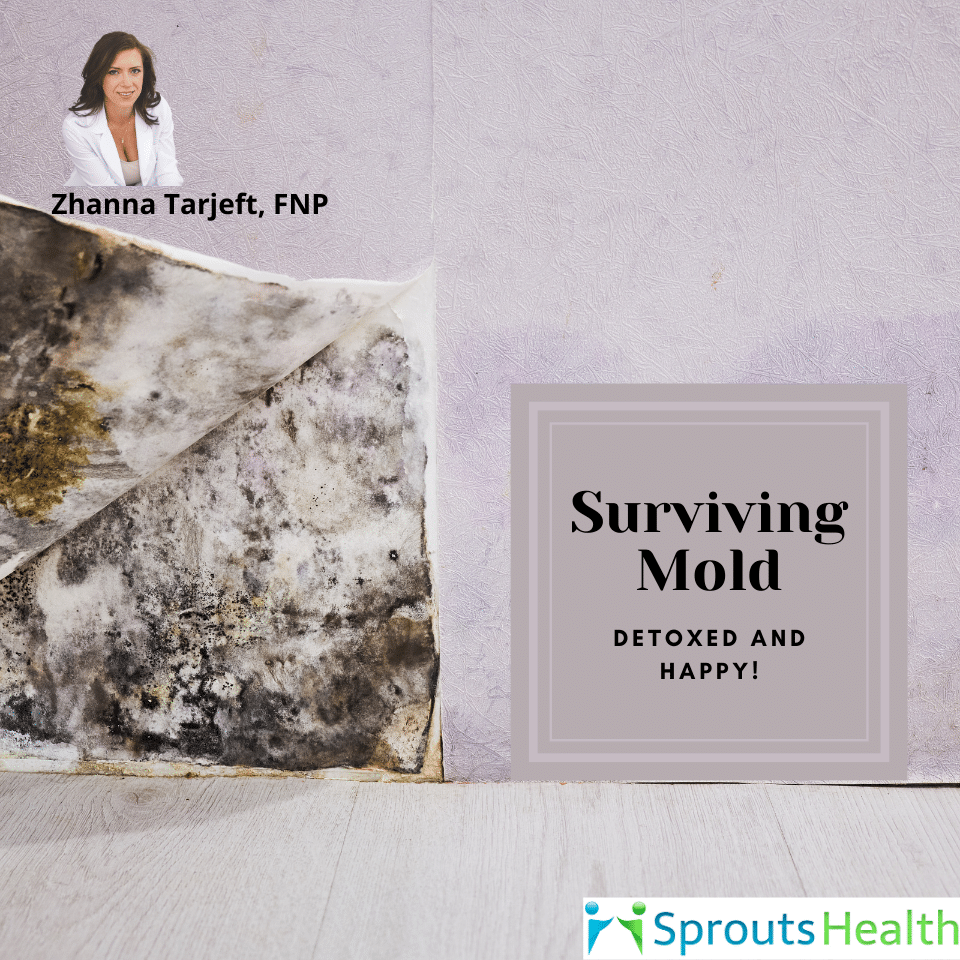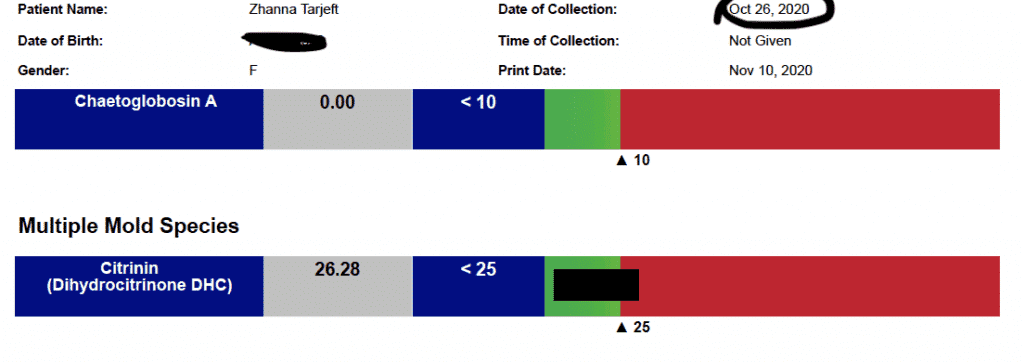
Our mold journey has happily ended at last, so I wanted to write a note of our family’s progress with the mycotoxin (mold toxins) detoxification. As no one treatment fits all, I had to modify the detoxification measures depending on the symptoms and the lab results from the Organic Acid Test and Mycotox Test by Great Plains Laboratory and Comprehensive Stool Test analysis by GI Maps and Doctor’s Data. Below you can find some lab test results from before and after. I have featured my own test results as my case was the hardest to treat and the most stubborn too, taking into consideration I have also had SIBO and SIFO treatments BEFORE we found mold in our house with 50-60% improvement – I still was not able to get 100% better and the OAT test showed mold colonization in the gut for me, and, thankfully, not for my husband or our daughter.

- Ochratoxin A – super high and consistent with Aspergillus mold contamination (exactly what the mold test of selected areas in our house showed).
- Mycophenolic Acid – Penicillum mold – the same – showed up high on the house mold test.

3. High levels – (through the roof) – Chaetoglobosin A made by Chaetomium that was also found in the house.
What is Chaetomium?
Honestly, I had no idea that there could be something worse than black mold, but, apparently, there is – Cheatomium (pronounced Ke-to-mi-um). It produces even more difficult to pronounce mycotoxin – Chaetoglobosin A!
Chaetomium is a mold found in water-damaged homes and buildings. It looks like cotton (is that why it was named that way?) and usually changes colors from white to grey to brown and eventually to black over time. Chaetomium mold is usually found in a leaking roof, damp dry walls, basements. It has musty odor. But we did not have this odor in our house as the mold damaged walls were dried and painted over with the fresh pain before we moved in. The sellers did not disclose the extensive damage that the house we were buying had. Chaetomium mold causes health effects such as skin and nail infections to name a few. Brain abscess, peritonitis, cutaneous lesions, and onychomycosis may also develop due to Chaetomium species. Actually, that is one reason we were very proactive in looking into the mold issue in our house – our 6-months-old daughter developed sandlike rash on her belly and behind her knees. We tried all the natural and unnatural things we could think of and it would disappear and then come back. The interesting piece of a puzzle was that the rash would appear in December and last through March when it rains more in Arizona. This pattern was repeated 3 times until we put all the pieces of the puzzle together. As soon as we moved out of our house during the 56-day remediation process, the rash disappeared within a week! My husband and I did not need any more proof than that.
So, back to Chaetomium. Unlike most other mold pathogens, there is medical evidence to suggest that people who are exposed to Chaetomium, have higher occurence of autoimmune diseases and certain forms of Cancer. It is hypothesized that Chaetomium mold exposure may also cause DNA damage!

Basically, these types of mold are not something I would want to find in our house or in our bodies! Moreover, the levels were so high – and my body was doing a pretty good job at detoxing the mycotoxin that they showed high on the test. Maybe, that explains that I got severe mold illness symptoms after 5 years in the house: I was good at detoxing mycotoxins until I got 3 doses of antibiotics


NO Chaetomium and Almost within range Citrinin
What Does Organic Acid Test Have to Do with Mold?
Here is the Organic Acid Test from March 2019 when we discovered Stachybortrys (black mold), Chaetomium, Aspergillus, Penicillium, and more in our house per the mold inspector testing. As we found mold in our house and in my body, I proceeded with the OATs testing/Stool test on our daughter and my husband, as well as Mycotox testing to see if they detox mold toxins well and if they developed gut issues.

High Yeast and Fungal Markers
The only marker in red is marker #7 Arabinose, consistent with some yeast issues, but the rest of the markers are way below the median and the markers for mold colonization (usually from Aspergillus) in the gut are almost non-existent. I definitely loved seeing this improvement in both my symptoms (no brain fog, no short-term memory loss, no impaired word recall) and the lab markers. After all, I do love seeing data and correlating it to the symptoms.

ALL Yeast and Fungal Markers, but ONE are within normal range

Bacterial Markers

After Treatment – Significantly Lower
Bacterial markers significantly improved too. As I mentioned before, mold detox takes time, and the effects of mold on gut health could be significant the longer one stays living in or being exposed to the moldy environment.
Our daughter’s comprehensive stool test analysis made me quite upset, to say the least. The low pancreatic function was the most concerning to me as it represents the impaired gut lining and high intestinal permeability (aka “leaky gut”). The symptoms did correlate with the general presentation of “leaky gut” – alternating constipation and diarrhea were concerning, whereas previously our child has had very healthy poops. The eczema-type rash was also concerning to me as the side effects of the long-term steroid creams such as hydrocortisone and thinning of the skin was not in my book to raise a healthy child. If you have ever had a child who had a rash and consulted a conventional pediatrician or dermatologist – the treatment is almost always the same – hydrocortisone steroid cream. We have tried food elimination, by getting rid of many foods, rotating foods, etc. with minimal success. The skin got angrier and angrier and it miraculously coincided (now, that I think of it) with the rainy season in Arizona that for the last 4 years started usually in November-December and lasted until March.


Good Bye my Joint Pain!
This is a short story of how I discovered the mold issue in our house through first discovering it in my body. Fortunately, this story has a happy end where no sequelae of horrible things that could have happened did not happen to any of us. Symptoms of mold exposure may include headache, sore throat, runny nose, coughing, sneezing, watery eyes and fatigue. In those with asthma, asthma attacks can occur. In those with impaired immune systems, serious infection can occur.
The mold illness is also called CIRS and Biotoxin Illness and rightfully so because the symptoms could vary from person to person. Dr. Shoemaker organized the symptoms into clusters. Here are some unexplained symptoms that may warrant your attention and check for mold.
11 Signs of a Mold Illness
- Brain Fog, Memory Problems, Trouble Focusing, Headaches
- Numbness and Tingling
- Eye Problems like Red Eyes or Light Sensitivity
- Asthma and Sinus Problems like Cough or Shortness of Breath
- Tremors and Vertigo
- Digestive Issues like Change in Appetite, Diarrhea, Nausea, Abdominal Pain
- Metallic Taste in the Mouth
- Unexplained Muscle Cramping, Aches and Pains in the Joints, Persistent Nerve Pain
- Temperature Regulation or Night Sweats
- Excessive Thirst and Increased Urination
- Fatigue and Weakness
- Frequent electric shocks when the Metal is Touched.
